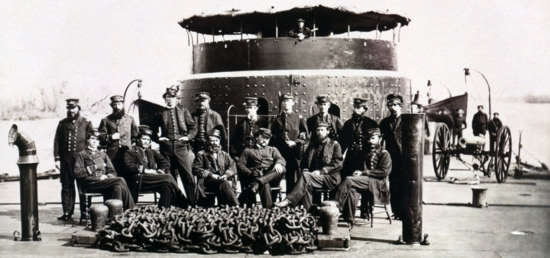JAN. 12, 2015 — Major General William Tecumseh Sherman captured Savannah on Dec. 21, 1864. In a telegram to President Lincoln, he offered, “I beg to present you as a Christmas gift the City of Savannah …”
 On Christmas Eve, Sherman wrote General Henry Halleck in Washington, “We are not only fighting armies, but a hostile people, and must make old and young, rich and poor, feel the hard hand of war, as well as their organized armies.”
On Christmas Eve, Sherman wrote General Henry Halleck in Washington, “We are not only fighting armies, but a hostile people, and must make old and young, rich and poor, feel the hard hand of war, as well as their organized armies.”
While still in Savannah, Sherman received a letter from Halleck offering, “Should you capture Charleston, I hope that by some accident the place may be destroyed, and if a little salt should be sown upon its site it may prevent the growth of future crops of nullification and secession.”
Sherman, however, had already decided to march on Columbia rather than Charleston. He replied to Halleck, “I will bear in mind your hint as to Charleston and don’t think salt will be necessary… The truth is the whole army is burning with insatiable desire to wreck vengeance upon South Carolina. I almost tremble at her fate.”
Union General John Foster was still in command in South Carolina. Even though Sherman was not going to march on Charleston, he was keenly aware of Foster’s burning desire to capture the city. Sherman communicated to Foster, “I regard any attempt to enter Charleston Harbor by its direct channel or to carry it by storm of James Island as too hazardous to warrant the attempt.”
While Sherman, at this point, felt that Charleston could not be taken, he urged Foster and Rear Admiral John Dahlgren with the navy to make a show of force periodically to occupy the Confederate forces in Charleston, prohibiting their withdrawal to reinforce any attempt to slow or stop the march on Columbia. On Jan. 2, 1865, Sherman’s troops crossed into South Carolina. By Jan. 15, the right wing of Sherman’s army reached Beaufort. Though Sherman knew he was heading to Columbia, the Confederate command was still eager to learn his intentions.
In Charleston, on the evening of Jan. 15, Dahlgren dispatched the monitor USS Patapsco on patrol to look for harbor obstructions. While still eight hundred yards from Fort Sumter, the ironclad monitor struck a torpedo. The impact of the explosion was off the port bow, just below the wardroom. Within twenty seconds, the ship went down, leaving only two feet of the smokestack visible. Sixty-two of the 105-man crew went down with the ship.
On Jan. 30, 1865, Union General Quincy Gillmore was ordered back to South Carolina to relieve Foster as commander of the Department of the South. Dahlgren was not pleased to see his old army colleague return. He recorded in his diary, “I have an entire contempt for Gillmore because of his conduct last year … So I briefly wrote to the Department stating that with his arrival to take command, asking to be relieved … I shall lose some prize money, too, but I will keep my self-respect which is better.”
By the end of January, Fort Sumter still had a Confederate garrison of three hundred men from the Thirty-second Georgia Volunteers and two companies of the First South Carolina Artillery. The fort, though, was still nothing more than an infantry outpost except for the three guns on the northeast face guarding the shipping channel. Even though Fort Sumter was hardly in a position to defend itself, the many Confederate guns at Fort Johnson on James Island and the multiple batteries on Sullivan’s Island created an effective crossfire on any Union ships that dared to approach the inner harbor.
As the month ends, it is clear that Sherman, with 60,000 troops, had turned toward the mid-state.




 We Can Do Better, South Carolina!
We Can Do Better, South Carolina!
























